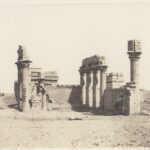
by Kirsten Blackham (Classics PhD, University of Glasgow)
While the search for Cleopatra’s tomb has been a central point of interest for archaeological research in the Ptolemaic period, there seems to be a curious lack of interest in the recovery of her Mammisi (or birth-temple) at Armant (ancient Hermonthis). Cleopatra VII’s Armant Mammisi is a significant source of information about her shared reign with her son, Pharaoh Ptolemy Caesarion; together, they were the last rulers of Egypt before its seizure by Rome.
The Mammisi was disassembled between 1861-62, and it has long been thought that the temple was disassembled for use in a sugar factory (Rutica 2015, 7). Although a significant amount of effort was put forth by early Egyptologists towards the preservation of Mammisi’s iconography as well as details pertaining to its physical structure and positioning prior to its destruction, it seems that no effort was made to verify where or how the materials taken from the Mammisi were used after its destruction.

Photography by Félix Teynard/ Imprimerie photographique H. de Fonteny et Cie – This file was donated to Wikimedia Commons as part of a project by the Metropolitan Museum of Art. See the Image and Data Resources Open Access Policy, Public Domain, https://commons.wikimedia.org/w/index.php?curid=60423134
A 2014 article by Dr Ralph Bodenstein, which focuses on identifying the number of sugar factories established by Ismail Khedive between 1867-1875, may shed some light on what may, or may not, have happened to Cleopatra VII’s Mammisi. Bodenstein notes that a sugar factory was built in Armant, which at first seems to be a likely candidate for the use of material from the Mammisi. However, this factory was built in the 1840s, considerably before the destruction of the Mammisi. While the factory was later renovated several times, Bodenstein notes that this was likely done using prefabricated materials and equipment (2014, 7).
According to accounts from the period, the sugar factories being developed after the destruction of the Mammisi were made primarily, or possibly exclusively, from prefabricated materials sourced from the French engineering companies Cail and Fives Lille. The prefabricated materials were likely shipped together as kits for a quick setup and to guarantee a seamless fit of the required machinery. These quick-build kits would later be known as ‘turnkey factories’ (2014, 21). Therefore, it is unlikely that the material from the Mammisi, which would have had to be cut to measure to work with the prefabricated material, would have been used for the development of the new factories.
Heinrich Stephan’s work Das Heutige Aegypten supports the argument for prefabricated metal structures becoming standard in Egyptian sugar factories by 1872 (Stephan 1872, 114-16). He also notably states that while ancient structures were being used as a source of material for construction projects during this period, it was not exclusively or even primarily in the factory buildings, but in homes for officials and other modern buildings nearby. Stephan gives the specific example of a Roman fort dated to the reign of Emperor Hadrian, which was deconstructed and used to build the summer palace of the Viceroy in Rhoda. He notes a specific stone used in the palace structure, which he describes as a containing a ‘well-preserved inscription written in honour of Antinous” (p.114). This point is reinforced by J.C. McCoan in Egypt As It Is, where he notes that until the late 1870s materials for new stone buildings in Cairo had been sourced from nearby temples and other ancient structures (McCoan 1877, 293). However, the comments about the context of the primary use of these structures witnessed by Stephan indicate an acknowledgment by Egyptian officials of the cultural and historical significance of decorated stone in contrast to that of plain stone sourced from these same structures. The use of Hadrian’s fort in the summer palace is key here. Stephan notes that the inscriptions were kept in excellent condition and that they were positioned in a way that would ensure their visibility to visitors. This reads not only as an acknowledgment of the significance of the inscriptions from the fort but also as an overt assertion of power and influence of the Viceroy and his family.
Given the circumstance of not only the growing reliance on imported pre-fabricated materials in the construction of Ismail Khedive’s Sugar factories but also the evidence of the use of materials from ancient structures in the development of government buildings and homes of government officials, it is possible that Cleopatra VII’s Mammisi was not wholly or even partially used in the development of a sugar factory despite the belief among Egyptologists. If this is true, then it is possible that if given the proper time and effort, there may be potential for at least the partial recovery of a temple that was once thought entirely lost.
Bibliography
Bodenstein, Ralph. 2014. “Sugar and Iron: Khedive Ismail’s Sugar Factories in Egypt and the Role of French Engineering Companies (1867-1875).” ABE Journal, no. 5. https://doi.org/10.4000/abe.2498.
McCoan, J. C. 1877. Egypt As It Is. New York, NY: Henry Holt & Company.
Rutica, Daniela. 2015. Kleopatras Vergessener Tempel. Das Geburtshaus von Kleopatra VII. in Hermonthis. Eine Rekonstruktion Der Dekoration (Göttingen : Seminar für Ägyptologie und Koptologie der Georg-August-Universität)
Stephan, Heinrich. 1872. Das Heutige Aegypten: Ein Abriss Seiner Physischen, Politischen, Wirthschaftlichen Und Cultur-Zustande. Leipzig: F. A. Brockhaus.

